Target COL17A1: Alteration of hair follicle stem cell division leads to thinning of hair
- Normal Liver Cells Found to Promote Cancer Metastasis to the Liver
- Nearly 80% Complete Remission: Breakthrough in ADC Anti-Tumor Treatment
- Vaccination Against Common Diseases May Prevent Dementia!
- New Alzheimer’s Disease (AD) Diagnosis and Staging Criteria
- Breakthrough in Alzheimer’s Disease: New Nasal Spray Halts Cognitive Decline by Targeting Toxic Protein
- Can the Tap Water at the Paris Olympics be Drunk Directly?
Target COL17A1: Alteration of hair follicle stem cell division leads to thinning of hair
- Should China be held legally responsible for the US’s $18 trillion COVID losses?
- CT Radiation Exposure Linked to Blood Cancer in Children and Adolescents
- Can people with high blood pressure eat peanuts?
- What is the difference between dopamine and dobutamine?
- What is the difference between Atorvastatin and Rosuvastatin?
- How long can the patient live after heart stent surgery?
Target COL17A1: Alteration of hair follicle stem cell division leads to thinning of hair. which inspires new treatments for hair loss.
The study also showed that human and mouse hair follicle stem cells (HFSC) have similar atypical stem cell division procedures during aging.
Therefore, the above-mentioned study has discovered the truth about hair loss caused by aging, and also found a potential therapeutic target—— COL17A1 also provides a new method for regulating organ aging and treating aging-related diseases.
Hair loss has always been a very distressing problem for humans, and the progress of human treatment of hair loss is obviously far behind the progress of human science and technology.
Moreover, the problem of hair loss, it seems that money cannot be solved, otherwise, Amazon President Bezos should not be so thorough.
Although hair loss does not cause serious health problems, it can seriously affect personal image, thereby impairing self-esteem and bringing emotional trauma. In severe cases, it can even lead to depression.
This phenomenon is more common among young men and women. Regrettably, despite the large number of people plagued by hair loss, there is currently no effective solution.
As we all know, hair grows from stem cells in hair follicles. As aging progresses, the ability of hair follicles to grow hair is gradually lost, leading to thinning, hair loss, and even baldness.
But what is the reason why hair follicles lose their ability to grow hair? Can people regenerate hair by restoring hair follicle regeneration ability?
Recently, researchers from Tokyo Medical and Dental University published a research paper titled: Distinct types of stem cell divisions determine organ regeneration and aging in hair follicles [1] in Nature Aging, a sub-issue of the top international academic journal Nature.
The study found that the division pattern of young hair follicle stem cells is not the same as that of old hair follicle stem cells.
The old hair follicle stem cells divide more asymmetrically and gradually decrease, leading to thinning hair and hair loss.
More importantly, based on these findings, the research team found COL17A1, a potential target that is expected to restore the normal division of hair follicle stem cells, thereby saving hair loss and treating organ aging.
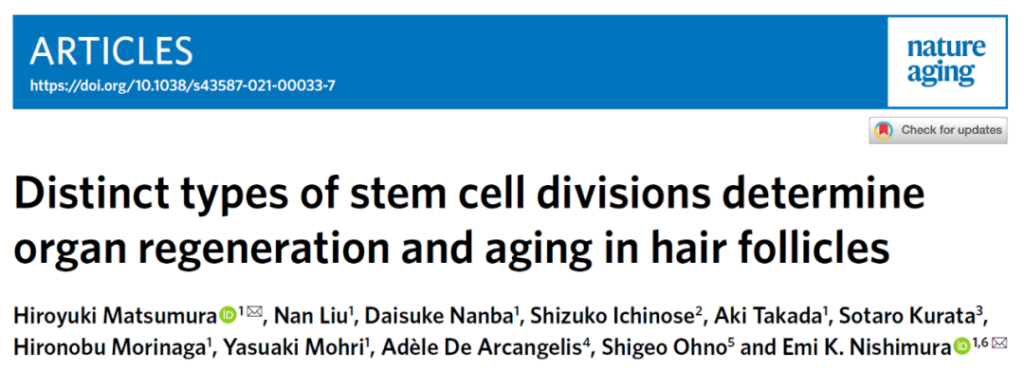
Hair follicles are miniature organs from which new hair continuously grows. The basis of new hair growth is the normal function of hair follicle stem cells (HFSC).
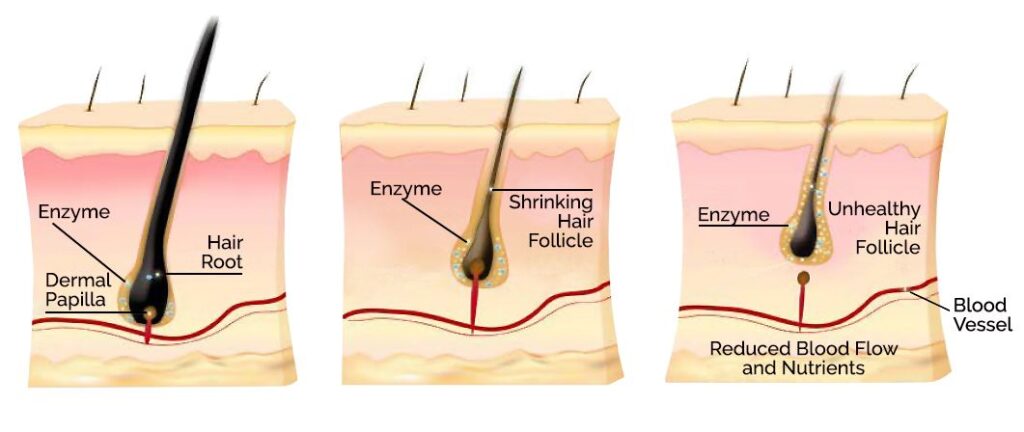
There are two types of hair follicle stem cell (HFSC) division: symmetrical division (SCD) and asymmetrical cell division (ACD).
Symmetrical division is to produce two stem cells that are the same as before and continue the same cell fate, while asymmetrical division produces a differentiated cell and a self-renewing stem cell.
These two ways of splitting exist at the same time and balance each other, which are necessary to ensure the normal function of organs and tissues.
Once these stem cells are affected by certain factors, the two ways of dividing are out of balance, and the organs will be damaged.
The research team focused on the division of these hair follicle stem cells, hoping to understand what changes have taken place in the hair follicle stem cells during the aging process, and whether these changes have caused hair loss.
In order to achieve the above research goals, the research team used two different types of measurement methods to study cell division in hair follicle stem cells (HFSC) of young and old mice: cell fate tracking and cell division axis analysis.
The former can track cell division in real time through fluorescent labels, while the latter can quantify the number and type of cell division.
Through these two methods, the research team was surprised to find that the hair follicle stem cells (HFSC) of young mice divide symmetrically and symmetrically, while the hair follicle stem cells (HFSC) of old mice are obviously dominated by asymmetric division.
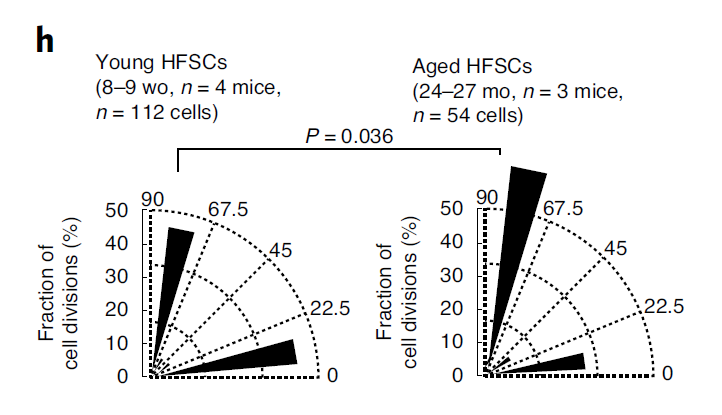
So why does the way of cell division change so drastically during the aging process?
Hemidesmosomes (hemidesmosomes), which connect cells to the extracellular matrix (ECM) proteins. For a long time, scientists have known that Cell-ECM can impart polarity to cells, that is, cells can perceive their location in a given space through the action of specific proteins.
The research team found that during aging, both hemidesmosomes and cell polarity proteins are unstable, which leads to abnormally differentiated cells during the division of hair follicle stem cells (HFSC).
The result of this is that over time, hair follicle stem cells (HFSC) are gradually depleted, leading to thinning and hair loss.
More importantly, in addition to discovering the causes of hair thinning and hair loss, the research team also found a solution on this basis.
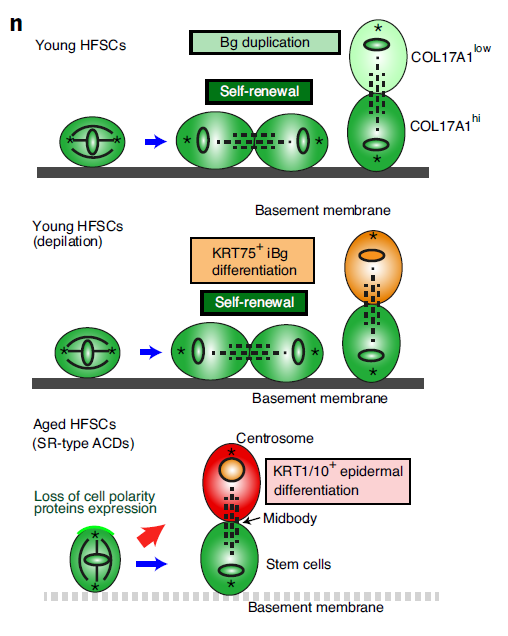
In April 2019, the research team published a paper in Nature [2] and found that the expression level of COL17A1 in all stem cells decreased, and the skin was also aging.
Therefore, the research team tried to restore the expression level of COL17A1 in this experiment, and found that after the increase of COL17A1 expression, it can significantly improve the asymmetric cell division (ACD)-based condition of hair follicle stem cells (HFSC) in old mice, and restore it To the relative equilibrium state of symmetrical division (SCD) and asymmetrical cell division (ACD).
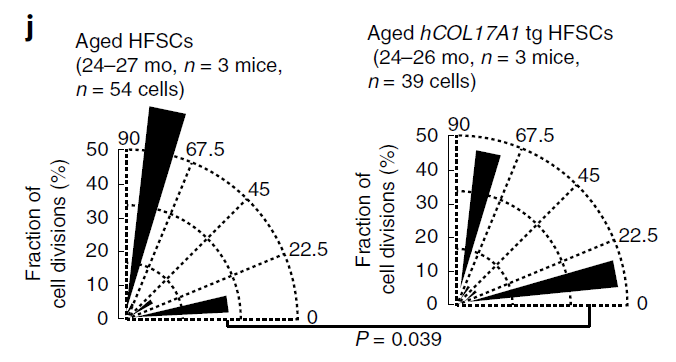
In addition, the study also showed that human and mouse hair follicle stem cells (HFSC) have similar atypical stem cell division procedures during aging.
Therefore, the above-mentioned study has discovered the truth about hair loss caused by aging, and has also found potential therapeutic targets. ——COL17A1 also provides a new method for regulating organ aging and treating aging-related diseases.
Target COL17A1: Alteration of hair follicle stem cell division leads to thinning of hair
(source:internet, reference only)
Disclaimer of medicaltrend.org
Important Note: The information provided is for informational purposes only and should not be considered as medical advice.



